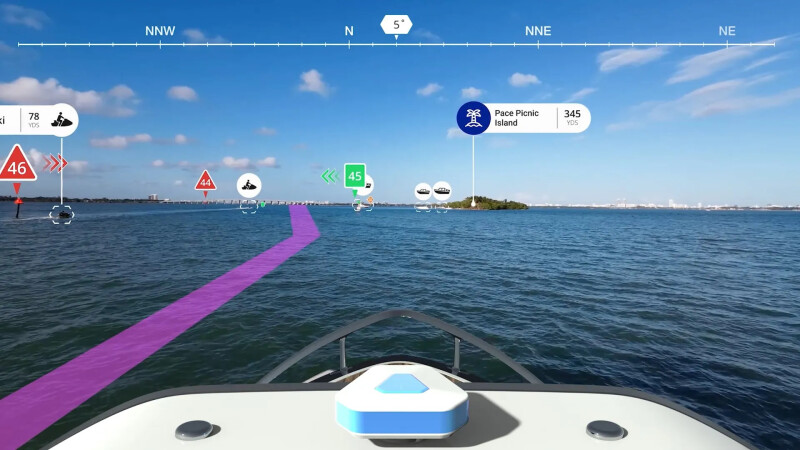LOOKOUT, an artificial intelligence (AI) pioneer in marine safety, revolutionizes marine navigation by launching the LOOKOUT camera system, designed to detect hazards beyond human capability. Built by a team of leading AI researchers, video game developers, 3D designers, and hardware engineers, the LOOKOUT camera system uses advanced computer vision algorithms to detect and track every marine hazard, such as other vessels, buoys, debris, whales, and even people in the water.
The National Fisherman team had the pleasure of heading out on Casco Bay, Maine, to get a firsthand view through the official LOOKOUT camera with the company’s CEO, David Rose. We were able to experience the advanced computer vision algorithms to spot hazards, creating a safer boating experience for commercial and recreational boaters alike.
“We're living in an era where AI, augmented reality, and spatial computing are transforming navigation and safety,” said Rose.
“Commercial vessels should benefit from the same innovation we see in automotive and aerospace. LOOKOUT integrates AI tech with intuitive, beautiful, and beneficial software design, providing clarity, especially in challenging conditions like low light, fog, and crowded harbors.”
Zach Whitener, the vessel safety officer at the Gulf of Maine Research Institute (GMRI), recently tried out LOOKOUT on the Institute’s vessel. Located in Portland, Maine, GMRI is an independent, nonpartisan marine nonprofit that supports the Gulf of Maine ecosystem and the communities that depend on it.
Whitener’s main role with GMRI is to research fish populations, manage and maintain the research vessel, and be the primary captain for various research projects. He was also part of a team that supported LOOKOUT through the GMRI-led Blue w(ai)ve accelerator program — which serves early-stage companies leveraging artificial intelligence in ocean-based solutions.
Whitener grew up within the islands of Casco Bay. In addition to his position at GMRI, he owns and operates his own company, Anadromous Adventures Guide Service LLC, so to say he spends his days on the water is an understatement.
His main concerns on the water are lobster buoys, other boats, and debris.
“Our research and sampling trips mean that we don’t just go out on the nicest days, in fact, much of our work takes place at night depending on the project. Steaming out in pitch black with a fiberglass hull and thinking about logs, or doing transects with gear hanging down into the water that fetch on buoys with toggles, means we always need to be fully aware of our surroundings no matter the visibility.”
LOOKOUT is a “supersight " that helps boaters see hazards that radar and AIS often don’t. The product provides a bird's-eye view during the day and at night. It was built in New England and acts as an active crew member, watching everything ahead and behind a vessel.
The system combines data from charts, AIS, radar targets, and online sources into a clear, 3D augmented reality view. This reduces a captain's cognitive load and enhances situational awareness, making decision-making more efficient while underway. LOOKOUT uses data from other NMEA-compatible sensors and integrates with modern multifunction displays from Garmin, Furuno, Raymarine, Simrad, and smartphones.
“This system could be a great benefit to many boats, especially if you operate in low visibility, whether that’s night, fog, or both. While many recreational boats only go out on the nice days, commercial vessels don’t have that luxury. We already have a lot on our minds at the helm and having another tool in the toolbox is always welcome,” Whitener shares.
The LOOKOUT system includes three components:
- LOOKOUT Camera: An AI-optimized eye on the water featuring infrared night vision, high-resolution daylight zoom, and 360-degree views for docking.
- LOOKOUT Brain: The most processing power ever deployed on a vessel, powered by NVIDIA technology to process multiple data streams and create an intuitive augmented reality view.
- LOOKOUT Cloud: An optional service for boats with StarLink or other internet connection, enabling community-driven data sharing.
“LOOKOUT's sensing and data-sharing capability is what boats need today,” remarked Todd Tally, Atlantic Marine Electronics' general manager, a VIKING Yachts subsidiary. “Knowing that a nearby vessel has detected a floating log or a whale is a game-changer. It's like having a network of lookout eyes on the water, ensuring everyone's safety.”
The LOOKOUT camera retails for $3,995. Customers can choose between the LOOKOUT Brain for $4,995 and the Brain PRO for $9,995, with the PRO version offering higher frame rates and resolution for detecting smaller, more distant targets. The product is shipping now.
For more information on LOOKOUT, please visit www.getalookout.com.







